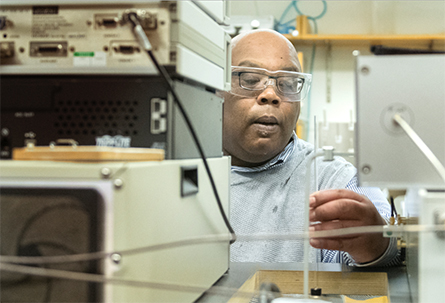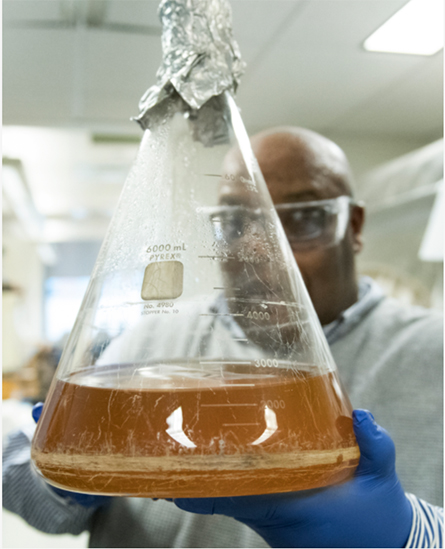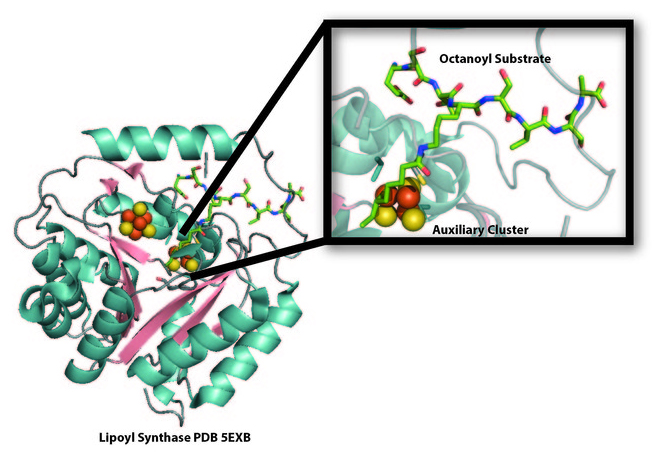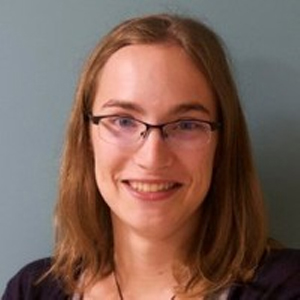Cellular signposts
A road trip to Florida is always memorable for kids, usually for the road snacks and sibling arguments rather than the highways they took to get there. But ask what cities and sketchy tourist traps they stopped at, and one might be able to reconstruct the route.

Squire Booker specializes in reconstructing routes from pins on the map, not along highways, but via chemical reactions.
“In chemistry, these pins represent what we call intermediates—the forms that molecules take along the way during a reaction’s various steps,” says Booker, a biochemist at Penn State. “Studying these intermediates gives us a better picture of how a reaction proceeds at each of its various steps. The more intermediates we identify, the better that picture is.”
Booker studies the intermediates of biological reactions that rely on a radical S-adenosylmethionine, or radical SAM, enzyme. Enzymes in this family are involved in a huge variety of chemical reactions within a cell, from the production of antibiotics, to modifying proteins after they are created, to catalyzing—speeding up—complex biological reactions. Disruption of radical SAM enzymes in humans can lead to a range of serious health problems including Type II diabetes, congenital heart disease, ALS, and increased susceptibility to viral infections.
Radical SAM enzymes are found in more than three thousand organisms, from humans to bacteria that live in oxygen-free environments, and are represented by more than 400,000 unique protein sequences. Researchers have documented over a hundred roles of radical SAM enzymes, but given the huge number of these enzymes that are still uncharacterized, that number is bound to increase.
“We don’t know what the majority of them do,” says Booker. “We have started to go through these enzymes to see what reactions they catalyze and how these reactions actually work.”

Booker has studied radical SAM enzymes for most of his academic career. He was working on a related project as a graduate student in the early 1990s when Perry Frey at the University of Wisconsin discovered the first radical SAM enzyme. A few years later, Booker joined Frey’s lab as a postdoctoral researcher. His work has since garnered him membership in the National Academy of Sciences—one of the highest honors accorded to U.S. scientists by their peers—and he has been named an Investigator with the prestigious Howard Hughes Medical Institute.
“We probably couldn’t get a grant from the major funding organizations to start cataloging these thousands of enzymes,” says Booker, “but with HHMI support, we can take a leap and start looking.”
A person, not a project
The non-profit HHMI, founded by billionaire aviator Howard Hughes in 1953, is one of the largest private funding organizations for biological and medical research in the United States. Because it funds a person rather than a project, its investigators—who begin as early career scientists and can periodically apply to renew their position—have freedom to take risks with their research.
While Booker spends most of his time teaching and doing research at Penn State, he is technically employed by HHMI, which rents his lab space at the University. In addition to more typical financial research support, HHMI also invests in technology at their investigators’ home institutions. Booker has used this support to acquire a variety of new instruments and other lab equipment, which has allowed him to take an any-means-necessary approach to investigate radical SAM enzymes and the reactions they catalyze.
“The support and resources from HHMI have been amazing and have allowed me to ask research questions I otherwise might not have,” he says.
His questions have led to important insights about the role of radical SAM enzymes in the human body, including how a compound called lipoic acid is created. Lipoic acid helps convert energy from food into a form that can be used by cells. Children deficient in lipoic acid suffer developmental delay, poor growth, seizures, and often, death.
The creation of lipoic acid is aided by a radical SAM enzyme called lipoyl synthase. Booker and his colleagues found that lipoyl synthase uses two sulfur atoms from an iron-sulfur cluster and then gives them to a different compound during the production of lipoic acid. Handing off the sulfur atoms renders the lipoyl synthase ineffective.
“It essentially kills itself, which just doesn’t make sense from a biological standpoint,” says Booker “A lot of people didn’t want to believe this finding when we first shared it.”
Booker and Penn State biochemist Carsten Krebs used spectroscopy to take a sort of picture of the sulfur molecules as the reaction progresses to see what steps are involved in this handoff. A high school student who worked in Booker’s lab, Martin McLaughlin, solved the X-ray crystal structure of the enzyme, and graduate student Erin McCarthy helped identify a key protein involved in the process. With these findings, the team went on to discover that another protein replaces the destroyed iron-sulfur cluster in lipoyl synthase almost as fast as it is removed, which allows the lipoyl synthase to keep producing lipoic acid.

the destruction of one of its iron-sulfur clusters (orange and yellow balls) to use as a sulfur source for the production of lipoic
acid. New research demonstrates that the iron-sulfur cluster that is destroyed during the production of lipoic acid is replaced
by an iron-sulfur carrier protein, NfuA, so that LipA can continue to produce lipoic acid.
Key collaborations
Booker has a flair for collaboration, frequently teaming up with scientists who have expertise in special techniques that, for example, provide information about the chemical identity of a reaction’s intermediates or that essentially take a picture of the intermediate at a particular point during the reaction.
“I think it’s fair to say that if it weren’t for Carsten, my research would have taken a very different direction,” says Booker. “I have also had valuable collaborations at Penn State with Amie Boal and Neela Yennawar, who bring expertise in X-ray crystallography, and Alexey Silakov, who is an expert in electron paramagnetic resonance spectroscopy.”
Booker also works with scientists at other institutions to take a genetics approach and to use bioinformatics methods to help determine the function of yet-undescribed radical SAM enzymes.
And his collaborations are not limited to faculty members. In addition to graduate students and postdocs, Booker has mentored more than 50 undergraduate students and two high school students in his lab, many of whom have provided key findings. High school student Edward Badding, son of the late Penn State chemist John Badding, made a breakthrough regarding the biosynthesis of a potent antibiotic.
“He almost single-handedly re-worked the pathway for how this antibiotic is made, correcting the previous work of some of the most influential people in the field,” says Booker.
Booker’s commitment to training the next generation of scientists reaches beyond his own lab. He coordinates the Summer Undergraduate Research Program within the Department of Chemistry and serves on the steering committee for the Annual Biomedical Research Conference for Minority Students. He also chaired the minority affairs committee for the American Society for Biochemistry and Molecular Biology, where he helped create mentoring initiatives for early career researchers in the field.
“I think it is important to provide motivated students with the ability to pursue research, especially those who might not otherwise have the opportunity,” says Booker, whose own research experience as an undergraduate profoundly influenced his career. Between terms at tiny Austin College, in Sherman, Texas, he joined the inaugural cohort of a minority summer science program at MIT. “This program, geared toward addressing the issue of low numbers of minority students pursuing science-based careers, has blossomed tremendously, and I am proud to have been a part of it.”
Booker’s interest in enzymology was sparked that summer, and he later returned to MIT as a graduate student to continue the research he started during the program.
“I had a great time during that summer, and being at MIT and in Boston in general was a real eye-opener,” he says. “It helped to cement my desire to pursue a job in basic research.”
Their experiences in his lab at Penn State may have been just as pivotal for McLaughlin and Badding. Both are now pursuing doctoral degrees, where they continue to explore the enzymatic roadmaps they first studied under Booker’s guidance—and add new pins of their own.
This article was originally published on the Penn State News website.Enjoy reading ASBMB Today?
Become a member to receive the print edition four times a year and the digital edition monthly.
Learn moreGet the latest from ASBMB Today
Enter your email address, and we’ll send you a weekly email with recent articles, interviews and more.
Latest in People
People highlights or most popular articles

In memoriam: Michael J. Chamberlin
He discovered RNA polymerase and was an ASBMB member for nearly 60 years.

Building the blueprint to block HIV
Wesley Sundquist will present his work on the HIV capsid and revolutionary drug, Lenacapavir, at the ASBMB Annual Meeting, March 7–10, in Maryland.

In memoriam: Alan G. Goodridge
He made pioneering discoveries on lipid metabolism and was an ASBMB member since 1971.

Alrubaye wins research and teaching awards
He was honored at the NACTA 2025 conference for the Educator Award and at the U of A State and National Awards reception for the Faculty Gold Medal.

Designing life’s building blocks with AI
Tanja Kortemme, a professor at the University of California, San Francisco, will discuss her research using computational biology to engineer proteins at the 2026 ASBMB Annual Meeting.

Jordahl named Gilliam Fellow
He will receive three years of funding to support his thesis research.

